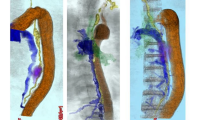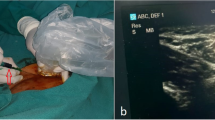Abstract
Background
Preoperative simulation of the thoracic duct using magnetic resonance thoracic ductography (MRTD) would enable a safe lymph node dissection near the thoracic duct and the prevention of chylothorax after an esophagectomy. The aim of this study was to determine whether MRTD is useful for preventing injury to the thoracic duct during surgery and for reducing the incidence of chylothorax after surgery.
Methods
We evaluated 130 patients who underwent preoperative MRTD followed by a thoracoscopic esophagectomy for the treatment of thoracic esophageal cancer between August 2014 and April 2017 (MRTD group). These patients were then compared with 160 patients with esophageal cancer who underwent a thoracoscopic esophagectomy without preoperative MRTD (non-MRTD group).
Results
Four patients in the non-MRTD group developed Type IIIB chylothorax (International Consensus on Standardization), while none of the patients in the MRTD group developed Type III chylothorax. Some type of abnormal finding was found during MRTD in 24 patients (18.5%). Among them, 13 patients (10.0%) exhibited abnormal divergence, which was the most frequent finding, followed by 5 patients (3.8%) with window formation and 2 patients (1.5%) with stitch formation.
Conclusions
The present study revealed the frequencies of abnormal findings of the thoracic duct and of patients with false-negative MRTD findings. Injury to the thoracic duct can be avoided through the use of appropriate care during procedures performed in patients with abnormal findings on preoperative MRTD.



Similar content being viewed by others
References
Udagawa H, Ueno M, Shinohara H et al (2014) Should lymph nodes along the thoracic duct be dissected routinely in radical esophagectomy? Esophagus 11:204–210
Kotani M (1990) The lymphatics and lymphoreticular tissues in relation to the action of sex hormones. Arch Histol Cytol 53:1–76
Van der Putte SCJ, van Limborgh J (1980) The embryonic development of the main lymphatics in man. Acta Morphol Neerl Scand 18:323–335
Williams KR, Burford TH (1964) The management of chylothorax. Ann Surg 160:131–140
Wemyss-Holden SA, Launois B, Maddern GJ (2001) Management of thoracic dust injuries after oesophagectomy. Br J Surg 88:1442–1448
Ozawa S, Ito E, Kazuno A et al (2013) Thoracoscopic esophagectomy while in a prone position for esophageal cancer: a preceding anterior approach method. Surg Endosc 27:40–47
Nomura T, Niwa T, Kazama T et al (2016) Balanced turbo field echo with extended κ-space sampling: a fast technique for the thoracic ductography. Magn Reson Med Sci 15:405–410
Low DE, Alderson D, Cecconello I et al (2015) International consensus on standardization of data collection for complications associated with esophagectomy. Esophagectomy Complications Consensus Group (ECCG). Ann Surg 262:286–294
Hayashi S, Miyazaki M (1999) Thoracic duct: visualization at nonenhanced MR lymphography—initial experience. Radiology 212:598–600
Okuda I, Udagawa H, Takahashi J et al (2009) Magnetic resonance-thoracic ductography: imaging aid for thoracic surgery and thoracic duct depiction based on embryological consideration. Gen Thorac Cardiovasc Surg 57:640–646
Yu DX, Ma XX, Wang Q et al (2013) Morphological changes of the thoracic duct and accessory lymphatic channels in patients with chylothorax: detection with unenhanced magnetic resonance imaging. Eur Radiol 23:702–711
Takanami K, Ichikawa H, Fukuda H et al (2012) Three-dimensional lymphoscintigraphy using SPECT/CT and 123I-BMIPP for the preoperative detection of anatomical anomalies of the thoracic duct. Clin Nucl Med 37:1047–1051
Adachi B (1953) Der Ductus Thoracicus der Japaner. In: Das Lymphgefasssystem der Japaner, Kenkyu-sha, Tokyo, p 1–83
Okuda I, Udagawa H, Hirata K et al (2011) Depiction of the thoracic duct by magnetic resonance imaging: comparison between magnetic resonance imaging and the anatomical literature. Jpn J Radiol 29:39–45
Dougenis D, Walker WS, Cameron EW et al (1992) Management of chylothorax complicating extensive esophageal resection. Surg Gynecol Obstet 174:501–506
Lai FC, Chen L, Tu YR et al (2011) Prevention of chylothorax complicating extensive esophageal resection by mass ligation of thoracic duct: a random control study. Ann Thorac Surg 91:1770–1774
Mishra PK, Saluja SS, Ramaswamy D et al (2013) Thoracic duct injury following esophagectomy in carcinoma of the esophagus: ligation by the abdominal approach. World J Surg 37:141–146. https://doi.org/10.1007/s00268-012-1811-x
Altorki N, Kent M, Ferrara C et al (2002) Three-field lymph node dissection for squamous cell and adenocarcinoma of the esophagus. Ann Surg 236:177–183
Rao DV, Chava SP, Sahni P et al (2004) Thoracic duct injury during esophagectomy: 20 years experience at a tertiary care center in a developing country. Dis Esophagus 17:141–145
Shah RD, Luketich JD, Schuchert MJ et al (2012) Postesophagectomy chylothorax: incidence, risk factors, and outcomes. Ann Thorac Surg 93:897–904
Cefolio RJ, Allen MS, Deschamps C et al (1996) Postoperative chylothorax. J Thorac Cardiovasc Surg 112:1361–1366
Orringer MB, Bluett M, Deeb GM (1988) Aggressive treatment of chylothorax complicating trabshiatal esophagectomy without thoracotomy. Surgery 104:720–726
Kaburagi T, Takeuchi H, Oyama T et al (2013) Intraoperative fluorescence lymphography using indocyanine green in a patients with chylothorax after esophagectomy: report of a case. Surg Today 43:206–210
Dexter SPL, Martin IG, McMahonz MJ (1996) Radical thoracoscopic esophagectomy for cancer. Surg Endosc 10:147–151
Luketich JD, Alvelo-Rivera M, Buenaventura PO et al (2003) Minimally invasive esophagectomy: outcomes in 222 patients. Ann Surg 238:486–495
Smithers BM, Gotley DC, McEwan D et al (2001) Thoracoscopic mobilization of the esophagus: a 6-year experience. Surg Endosc 15:176–182
Author information
Authors and Affiliations
Corresponding author
Ethics declarations
Conflict of interest
The authors declare that they have no conflict of interest.
Rights and permissions
About this article
Cite this article
Oguma, J., Ozawa, S., Kazuno, A. et al. Clinical Significance of New Magnetic Resonance Thoracic Ductography Before Thoracoscopic Esophagectomy for Esophageal Cancer. World J Surg 42, 1779–1786 (2018). https://doi.org/10.1007/s00268-017-4372-1
Published:
Issue Date:
DOI: https://doi.org/10.1007/s00268-017-4372-1




